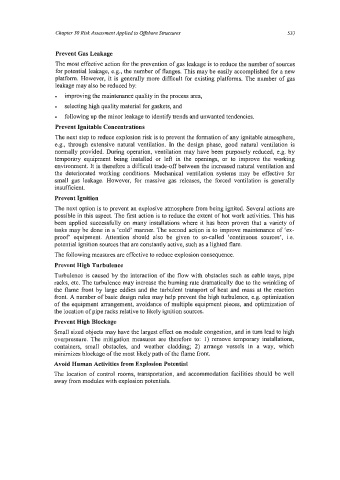Page 561 - Marine Structural Design
P. 561
Chapter 30 Risk Assessment Applied to Offshore Structures 537
Prevent Gas Leakage
The most effective action for the prevention of gas leakage is to reduce the number of sources
for potential leakage, e.g., the number of flanges. This may be easily accomplished for a new
platform. However, it is generally more difficult for existing platforms. The number of gas
leakage may also be reduced by:
improving the maintenance quality in the process area,
selecting high quality material for gaskets, and
following up the minor leakage to identify trends and unwanted tendencies.
Prevent Ignitable Concentrations
The next step to reduce explosion risk is to prevent the formation of any ignitable atmosphere,
e.g., through extensive natural ventilation. In the design phase, good natural ventilation is
normally provided. During operation, ventilation may have been purposely reduced, e.g. by
temporary equipment being installed or left in the openings, or to improve the working
environment. It is therefore a difficult trade-off between the increased natural ventilation and
the deteriorated working conditions. Mechanical ventilation systems may be effective for
small gas leakage. However, for massive gas releases, the forced ventilation is generally
insufficient.
Prevent Ignition
The next option is to prevent an explosive atmosphere from being ignited. Several actions are
possible in this aspect. The first action is to reduce the extent of hot work activities. This has
been applied successfully on many installations where it has been proven that a variety of
tasks may be done in a ‘cold’ manner. The second action is to improve maintenance of ‘ex-
proof equipment. Attention should also be given to so-called ‘continuous sources’, Le.
potential ignition sources that are constantly active, such as a lighted flare.
The following measures are effective to reduce explosion consequence.
Prevent High Turbulence
Turbulence is caused by the interaction of the flow with obstacles such as cable trays, pipe
racks, etc. The turbulence may increase the burning rate dramatically due to the wrinkling of
the flame front by large eddies and the turbulent transport of heat and mass at the reaction
front. A number of basic design rules may help prevent the high turbulence, e.g. optimization
of the equipment arrangement, avoidance of multiple equipment pieces, and optimization of
the location of pipe racks relative to likely ignition sources.
Prevent High Blockage
Small sized objects may have the largest effect on module congestion, and in turn lead to high
overpressure. The mitigation measures are therefore to: 1) remove temporary installations,
containers, small obstacles, and weather cladding; 2) arrange vessels in a way, which
minimizes blockage of the most likely path of the flame front.
Avoid Human Activities from Explosion Potential
The location of control rooms, transportation, and accommodation facilities should be well
away from modules with explosion potentials.

